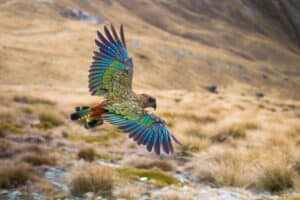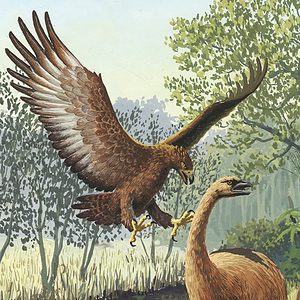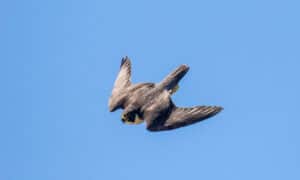North Carolina’s natural beauty is unmatched. From its sandy beaches to smokey mountains, there is an abundance of habitats perfect for all kinds of bird species. Do you need help identifying a blue backyard bird? Or did you spot a pop of brilliant indigo on your last hiking trip? Take a look at all the blue birds in North Carolina and find out where they live, what they eat, and how to identify them.
Indigo Bunting
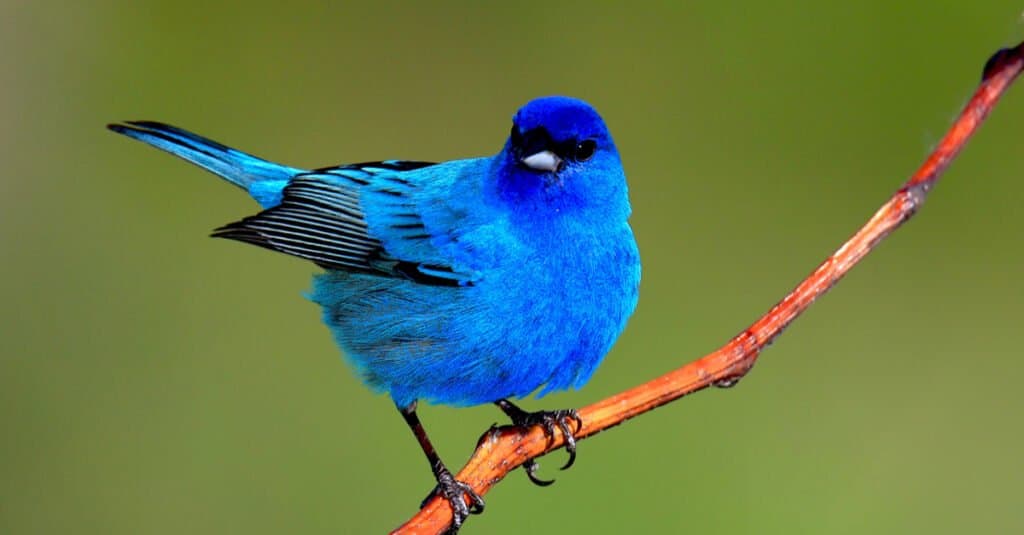
Look for them along woodland edges, fields, and streams.
©John L. Absher/Shutterstock.com
Habitat: The indigo bunting lives in brushy pastures and weedy areas. Look for them along woodland edges, fields, and streams. These long-distance migrants breed in the eastern half of the United States and winters in Mexico, Central America, and the very northern tip of South America.
Appearance: They are small, stocky birds with thick bills, short tails, and rounded wings. Breeding males are all blue, with lighter wings and backs and darker heads. They also have silver bills.
Diet: Seeds, insects, spiders, and berries
Calls: Bright, rapid warbles and sharp “chips”
Backyard Tip: Provide mealworms, thistle, and nyger
Common Grackle
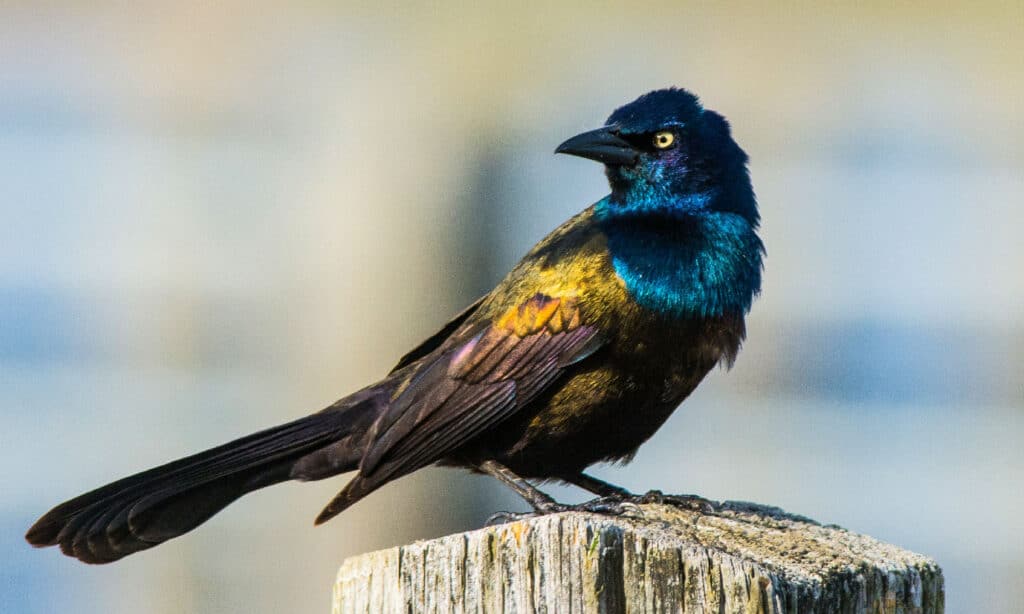
The IUCN lists the common grackle as NC or “near threatened.” This species is undergoing a continuous decline in its population.
©JoshCW Photo/Shutterstock.com
Habitat: Common grackles live year-round in the southeastern portion of the United States. But populations that breed in the northeast will migrate south for winter. You can find them on farmlands, towns, streams, and groves.
Appearance: These large, slender birds have long legs, long tails, and flat heads. This species can be difficult to spot because they appear all black from a distance, but their heads are blue and purple and their bodies are iridescent bronze.
Diet: Insects, spiders, fish, small reptiles, and bird’s eggs
Calls: High-pitched screeches and clucks
Backyard Tip: Spread grain and seed on the ground
Barn Swallow
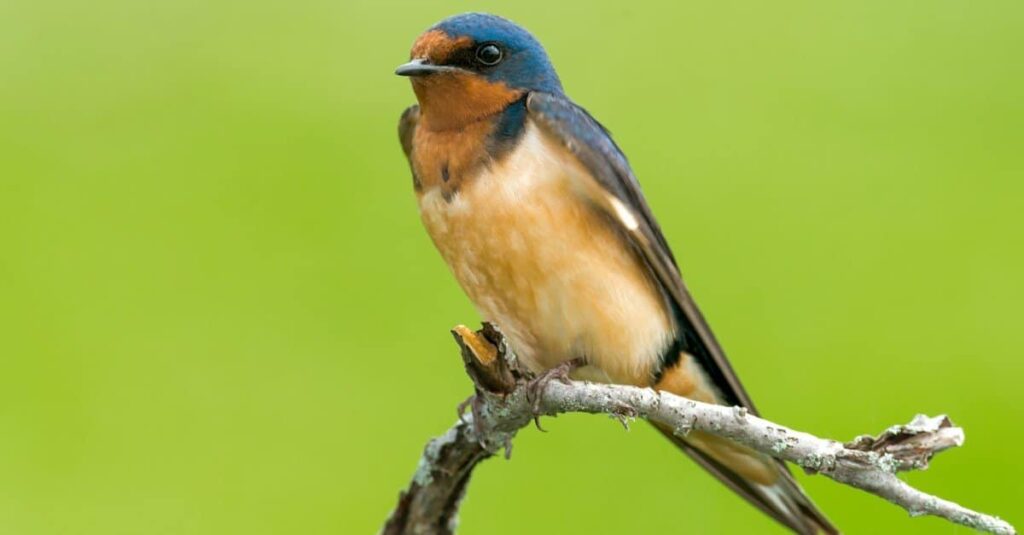
The barn swallow’s backs, wings, and tails are steely blue, and their undersides are rufous-colored.
©Paul Reeves Photography/Shutterstock.com
Habitat: The barn swallow is a familiar bird of rural open areas, such as farms, fields, and marshes. They spend spring and summer throughout the United States and Canada, migrating to Mexico and Central America during winter.
Appearance: They are small birds with flat heads, broad shoulders, and long, pointed wings. Their backs, wings, and tails are steely blue, and their undersides are rufous-colored.
Diet: Insects and spiders
Calls: Liquid twitter-warbles and “cheep” calls
Backyard Tip: Place ground-up eggshells in a platform feeder
Blue Grosbeak
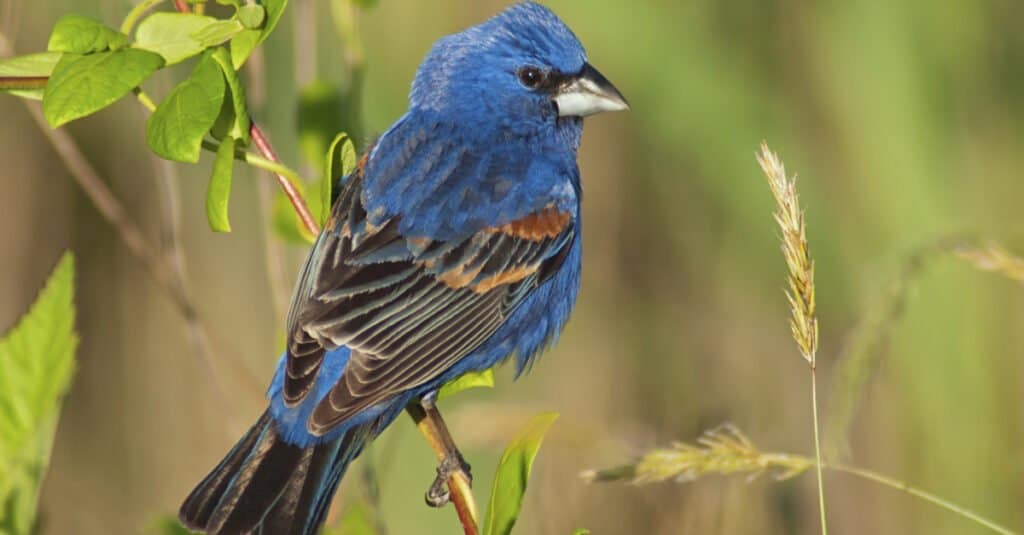
The blue grosbeak eats seeds, insects, spiders, and snails.
©Michael G. Mill/Shutterstock.com
Habitat: They live in brush and alongside roadsides and streamside thickets. Blue grosbeaks are long-distance migrants that spend their summers in the southern United States and their winters in Mexico and Central America.
Appearance: These stocky birds have large heads and triangular bills. They feature deep blue plumage, with reddish-brown wingbars and silver beaks.
Diet: Seeds, insects, spiders, and snails
Calls: Husky warbles and metallic “klinks”
Backyard Tip: Plants shrubs and place grains and seeds in a feeder
Eastern Bluebird
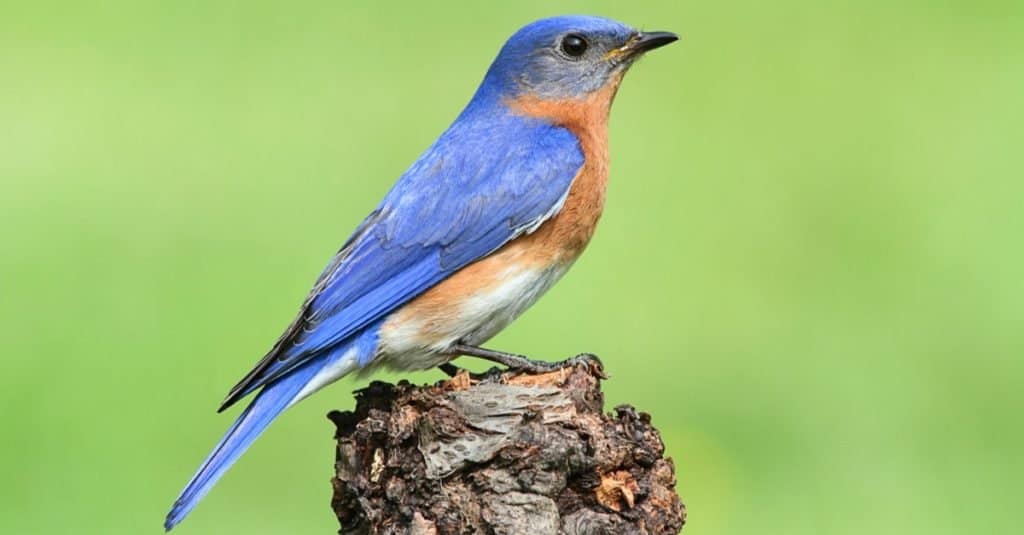
Eastern bluebirds produce low-pitched warbles.
©Steve Byland/Shutterstock.com
Habitat: Eastern bluebirds live year-round in North Carolina and other parts of the southeast. But populations that breed in the northeast migrate to the south during winter. You can find them in open country near roads and farms or occasionally in the suburbs.
Appearance: They are small, plump birds with rounded heads, long wings, and short tails. Males are bright, deep blue above and rusty red below.
Diet: Insects and berries
Calls: Low-pitched warbles and soft calls
Backyard Tip: Build a nestbox in your yard and provide mealworms
Blue Jay
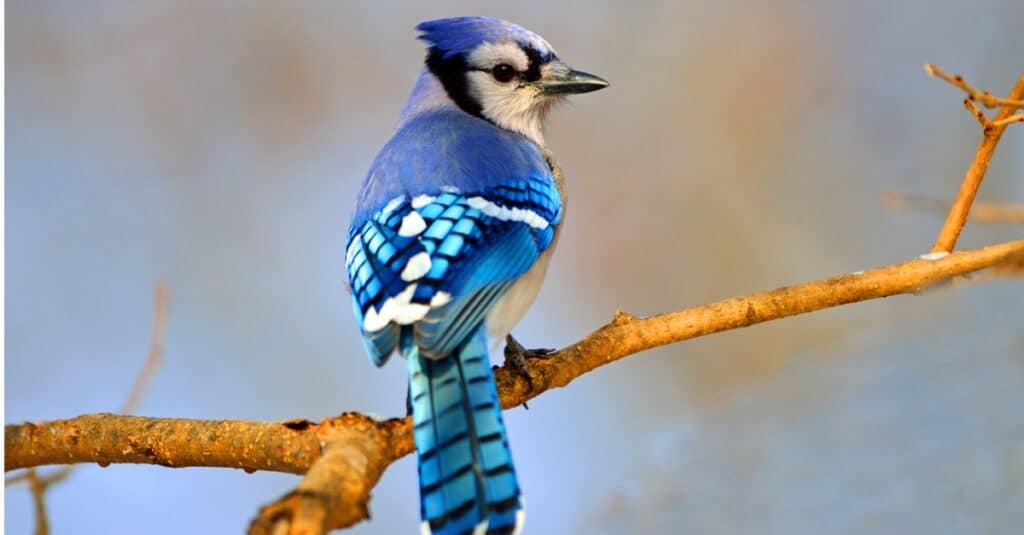
Blue jays live all year in North Carolina pine and oak woodlands, suburbs, and groves.
©iStock.com/BrianEKushner
Habitat: Blue jays live all year in North Carolina pine and oak woodlands, suburbs, and groves. They are familiar birds in towns, as well. Most populations are permanent in their environments, especially in the eastern half of the country.
Appearance: These large songbirds have distinct crests and long, rounded tails. They feature several shades of blue, black, and white above and whitish-gray below.
Diet: Acorns, seeds, nuts, grains, berries, small fruits, and insects
Calls: Harsh calls and quiet clicks
Backyard Tip: Blue jays like suet, peanuts, and sunflower seeds on tray feeders.
White-breasted Nuthatch
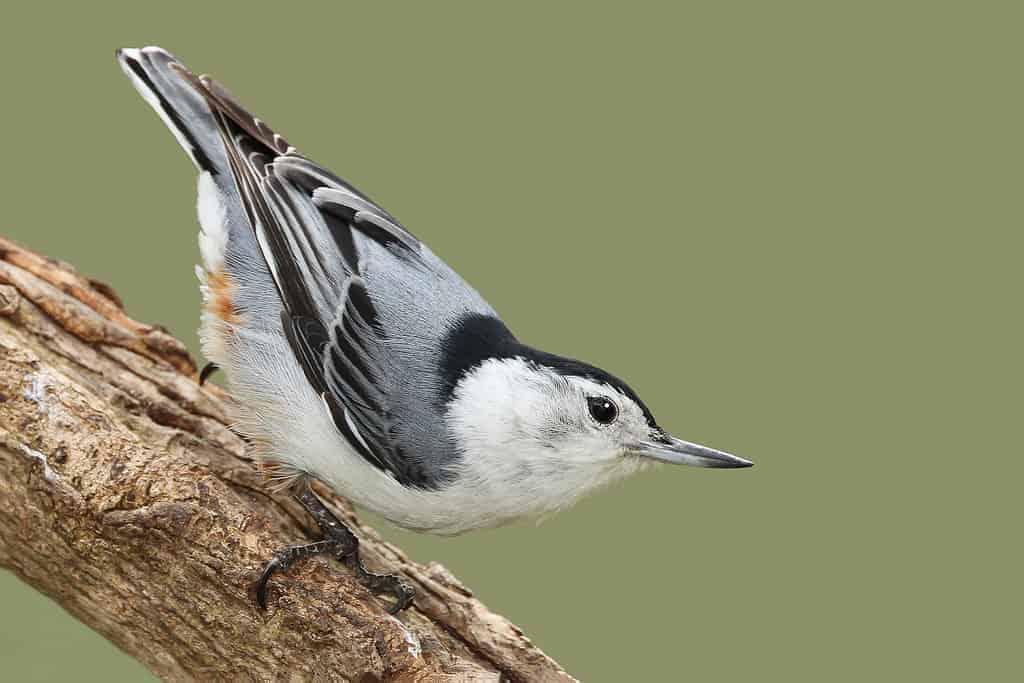
They are not an obvious blue color, but a duller grayish-blue, with black caps and white undersides.
©Brian Lasenby/Shutterstock.com
Habitat: These birds also live in North Carolina year-round. You can find them in mature deciduous forests, woodlots, clearings, and groves. They live all year throughout most of the United States.
Appearance: Nuthatches are small birds with large heads. The white-breasted species is the largest nuthatch and features a short tail and long bill. They are not an obvious blue color, but a duller grayish-blue, with black caps and white undersides.
Diet: Seeds and insects
Calls: Loud nasal calls and low whistles
Backyard Tip: Provide a nest box, sunflower seeds, suet, and peanuts
Northern Parula
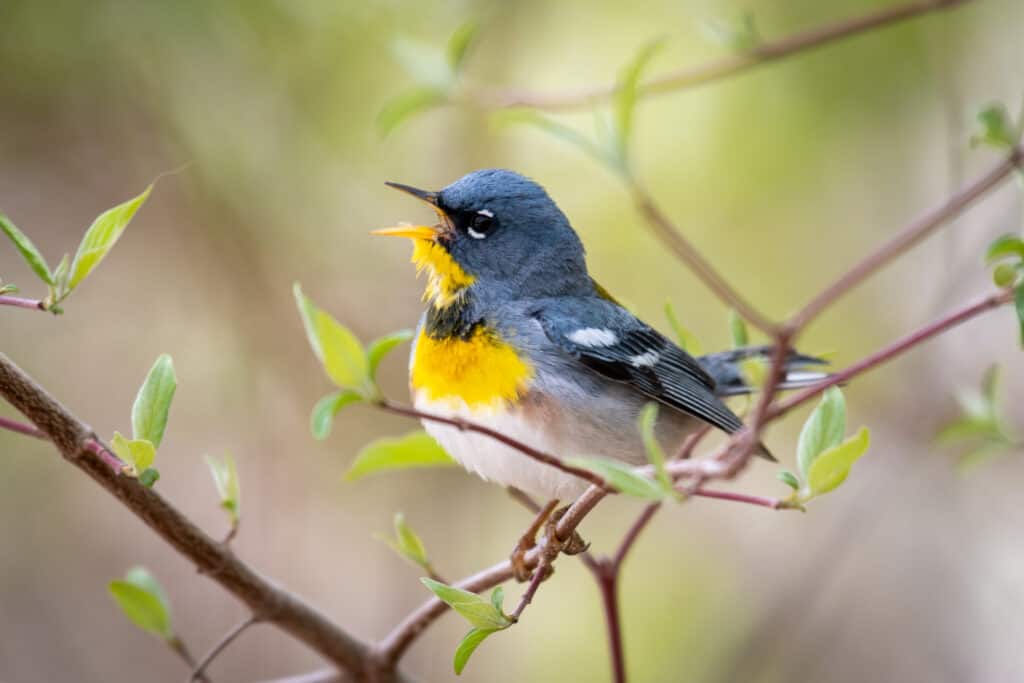
The northern parula is a small warbler that lives in forest canopies during summer and tropical plantations in the winter.
©Nattapong Assalee/Shutterstock.com
Habitat: These birds live in mature forests and humid woods with plenty of Spanish moss. Northern Parulas breed in the eastern United States, and you can find them in North Carolina during spring and summer.
Appearance: These small warblers have short tails and pointy bills. Adult males are bluish-gray above with greenish-yellow patches, white wingbars, and chestnut bands.
Diet: Insects, spiders, and berries
Calls: Buzzy trills and sharp chirps
Backyard Tip: Northern parulas don’t visit backyard feeders, but they may visit if you have native trees and shrubs.
Blue-gray Gnatcatcher
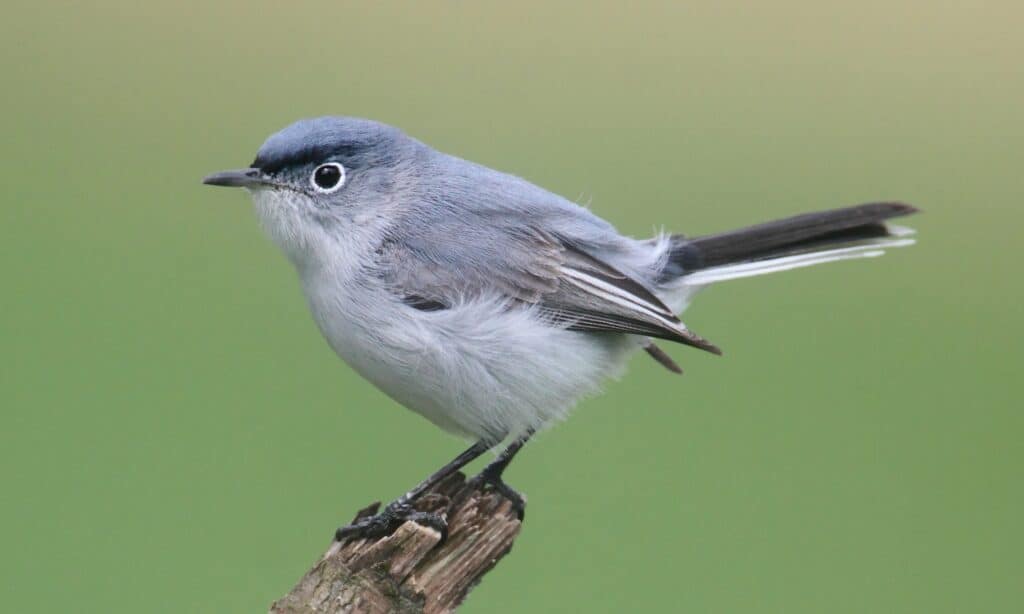
Most populations in North Carolina stay there for the breeding season. But some along the southern coasts stay year-round.
©iStock.com/SteveByland
Habitat: Blue-gray gnatcatchers live in open woods, deciduous forests, and thickets. Most populations in North Carolina stay there for the breeding season. But some along the southern coasts stay year-round.
Appearance: They are tiny, slender songbirds with long tails and straight bills. As their name implies, they have bluish-gray plumage above and white below. They also have a black “V” shape on their foreheads.
Diet: Insects and spiders
Calls: Thin warbles and nasal calls
Backyard Tip: This species does not typically visit backyards.
Belted Kingfisher
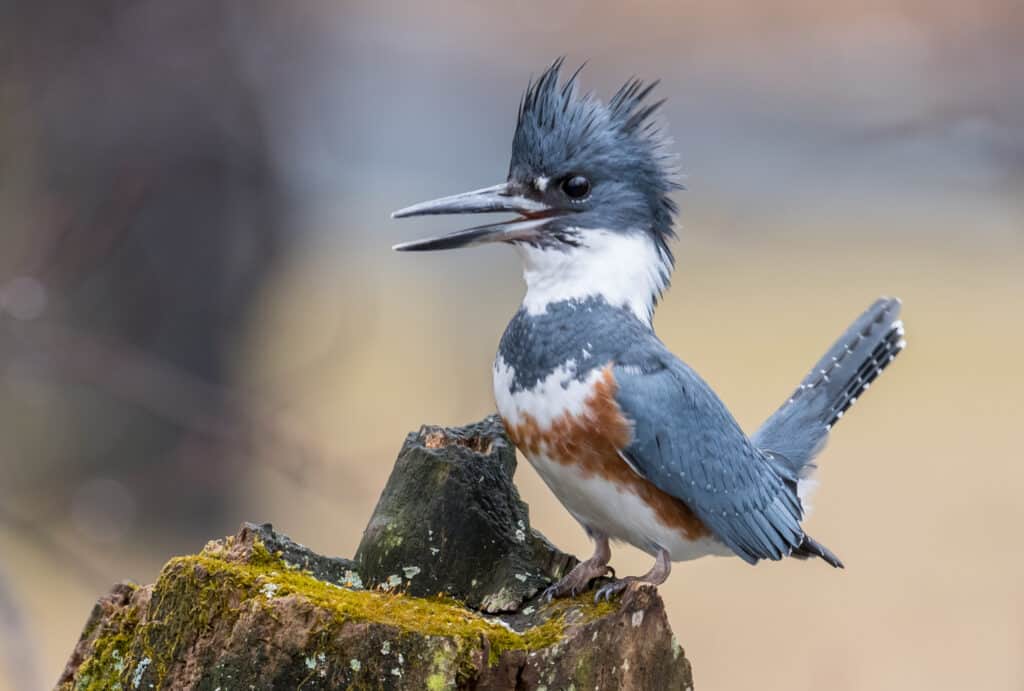
These stocky birds have large heads, shaggy crests, and long, thick bills.
©Harry Collins Photography/Shutterstock.com
Habitat: You can find the belted kingfisher near many types of water, such as streams, bays, lakes, and coasts. You can also see them in marshes and estuaries. They live year-round in most of the United States, including North Carolina.
Appearance: These stocky birds have large heads, shaggy crests, and long, thick bills. They have bluish-gray heads, backs, and breasts, with white undersides and throat bands.
Diet: Small fish, frogs, and aquatic insects
Calls: Loud rattles and scream calls
Backyard Tip: You may see a belted kingfisher on your property if you have a pond or small pool.
Red-breasted Nuthatch
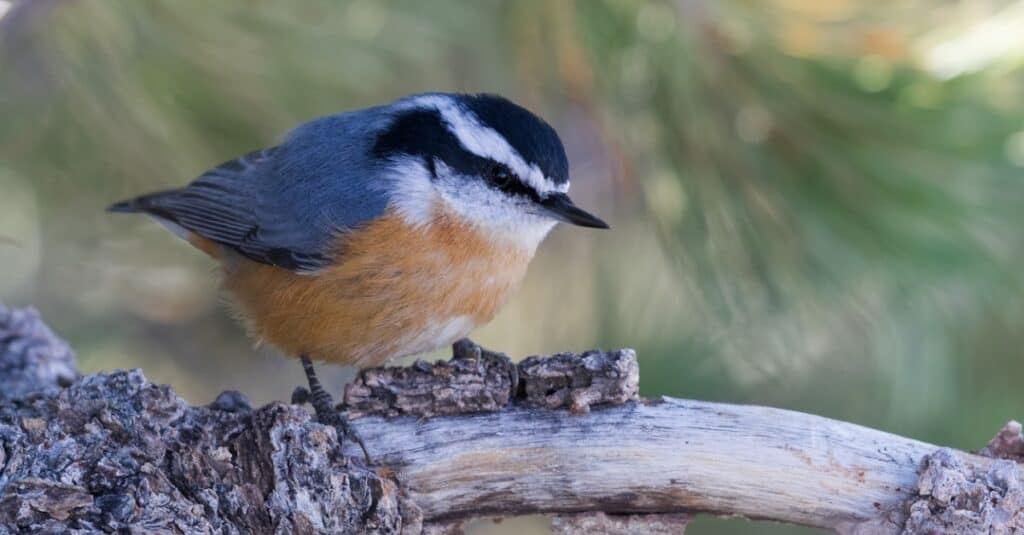
People often mistake nuthatches for woodpeckers because of their long, pointed beaks and their foraging behavior.
©iStock.com/M. Leonard Photography
Habitat: Red-breasted nuthatches live primarily in mature coniferous forests and other wooded areas. They are partial migrants, with some Canadian breeding populations wintering in the United States.
Appearance: They are compact birds with short tails and long bills. These are another bluish-gray bird but feature black and white heads and rusty-brown undersides.
Diet: Insects, spiders, and seeds
Calls: Fast nasal notes and vibrating trills
Backyard Tip: Offer peanuts, sunflower seeds, and peanut butter
Black-throated Blue Warbler
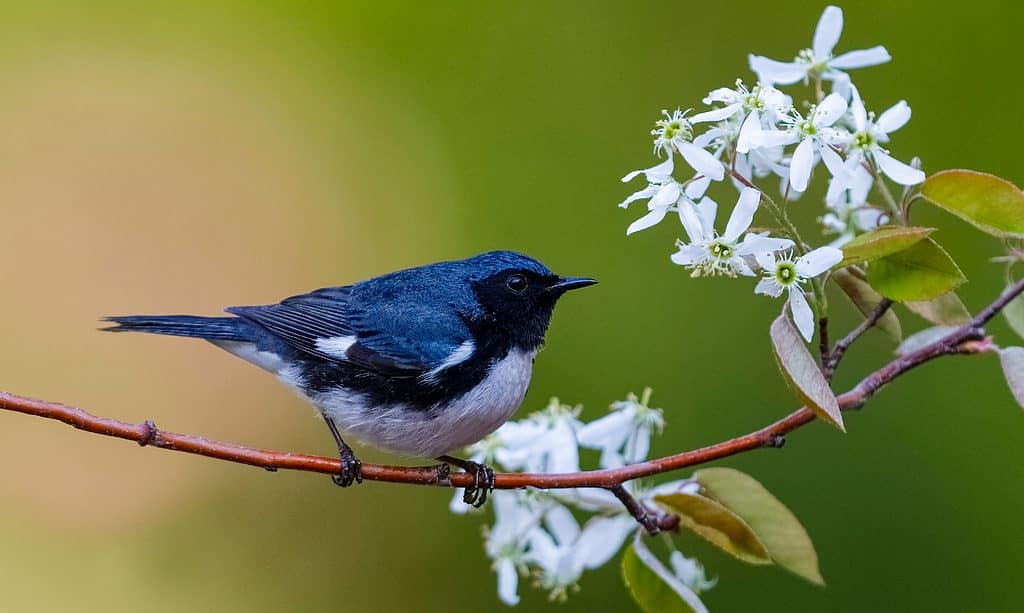
Adult males are dark blue above and white below, with black faces and throats.
©iStock.com/BrianLasenby
Habitat: These birds migrate through North Carolina, with some populations breeding in far western areas of the state. Look for them in forests with dense undergrowth or shrubby areas.
Appearance: These warblers are small and plump with pointed bills. Adult males are dark blue above and white below, with black faces and throats.
Diet: Insects, seeds, berries, small fruits, and flower nectar
Calls: Husky “zwee” songs
Backyard Tip: Black-throated blue warblers do not typically visit backyards.
Cerulean Warbler
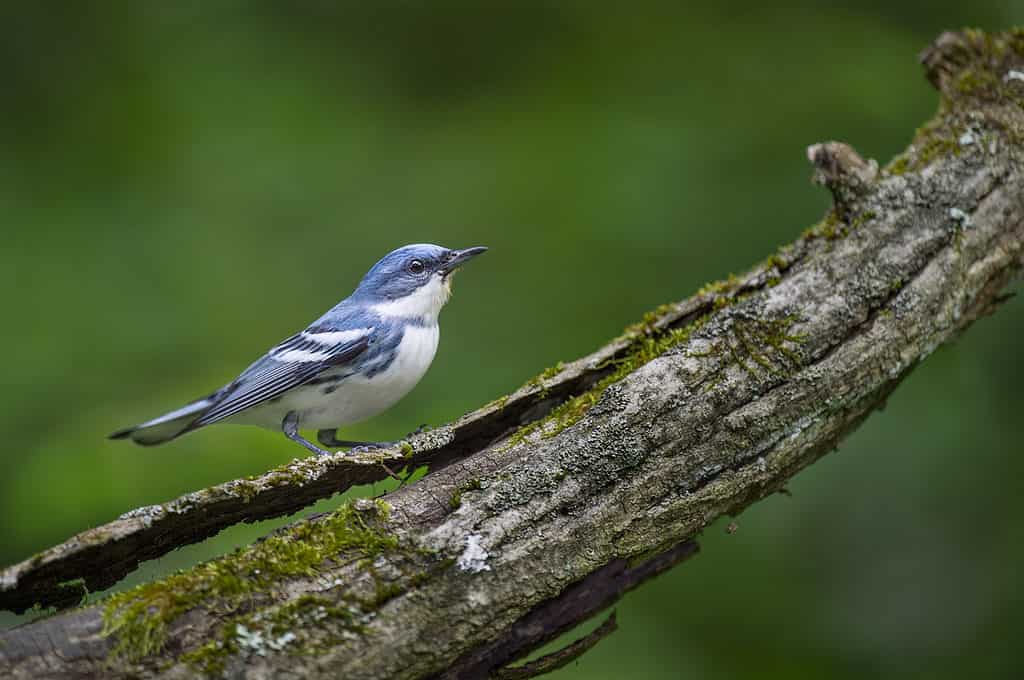
Like the black-throated blue warbler, the cerulean warbler migrates through North Carolina, with some groups breeding in far western areas.
©iStock.com/ps50ace
Habitat: You will find these birds in river valleys of deciduous forests. They also inhabit mature hardwoods along streams. Like the black-throated blue warbler, the cerulean warbler migrates through North Carolina, with some groups breeding in far western areas.
Appearance: Small and compact, this warbler has short tails and a round bill. Males are cerulean blue above and white below, with white wingbars and dark streaking.
Diet: Primarily insects
Calls: Short, high-pitched buzzy notes
Backyard Tip: You won’t find the cerulean warbler in most backyards.
Rock Pigeon
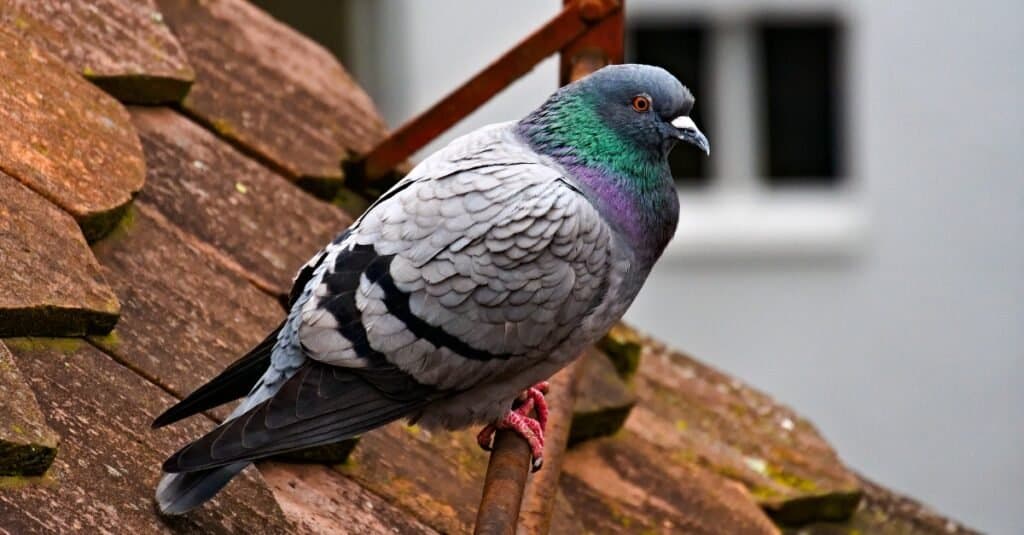
They vary in color, but most are bluish-gray, with black bands and iridescent throats.
©iStock.com/Christian Sturzenegger
Habitat: The rock pigeon lives year-round throughout the United States, including North Carolina. These birds are common in most habitations, including cities, towns, farms, and suburbs.
Appearance: These are large, plump birds with small heads and short legs. They vary in color, but most are bluish-gray, with black bands and iridescent throats.
Diet: Seeds, berries, acorns, insects, and human food
Calls: Soft coos
Backyard Tip: Rock pigeons like open areas with seeds and other food scattered on the ground.
Tree Swallow
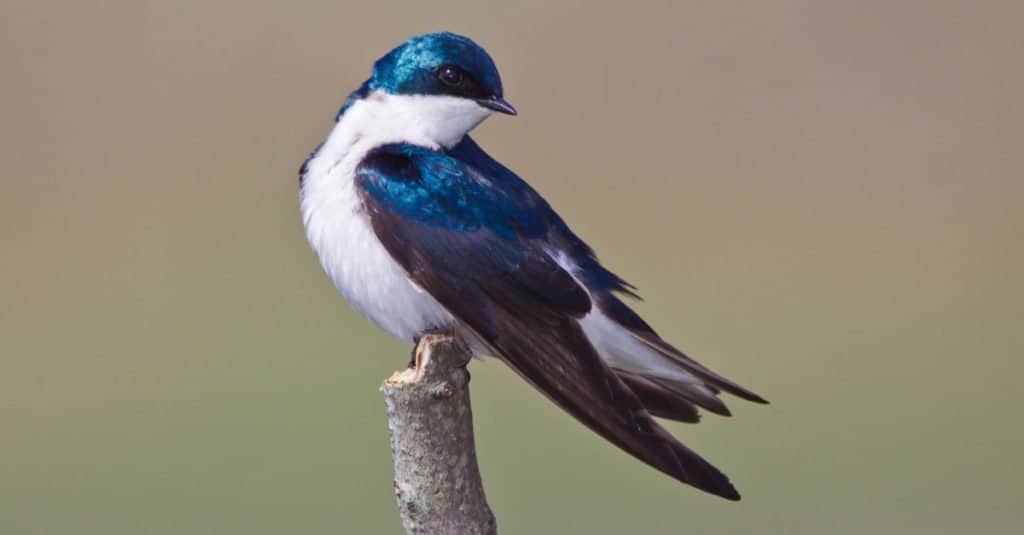
Tree swallows eat insects, berries, and seeds.
©Elliotte Rusty Harold/Shutterstock.com
Habitat: The tree swallow is unique in North Carolina, wintering on the coast, breeding in the far west, and migrating through the rest of the state. You can find them in open country near water, such as marshes, lakes, meadows, and coasts.
Appearance: These birds are small with long, pointed wings and short, notched tails. Adult males are bluish-green above and white below with brownish-black wings and tails.
Diet: Insects, berries, and seeds
Calls: Cheerful twitters
Backyard Tip: Put up a nest box and provide eggshells
Up Next:
- Animals in North Carolina
- Discover 10 Fascinating Lizards in North Carolina
- Discover The 7 Largest Animals In South Carolina, and Where You’ll Find Them
The photo featured at the top of this post is © Tom Reichner/Shutterstock.com
Sources
- IUCN RedList, Available here: https://www.iucnredlist.org/
Thank you for reading! Have some feedback for us? Contact the AZ Animals editorial team.



